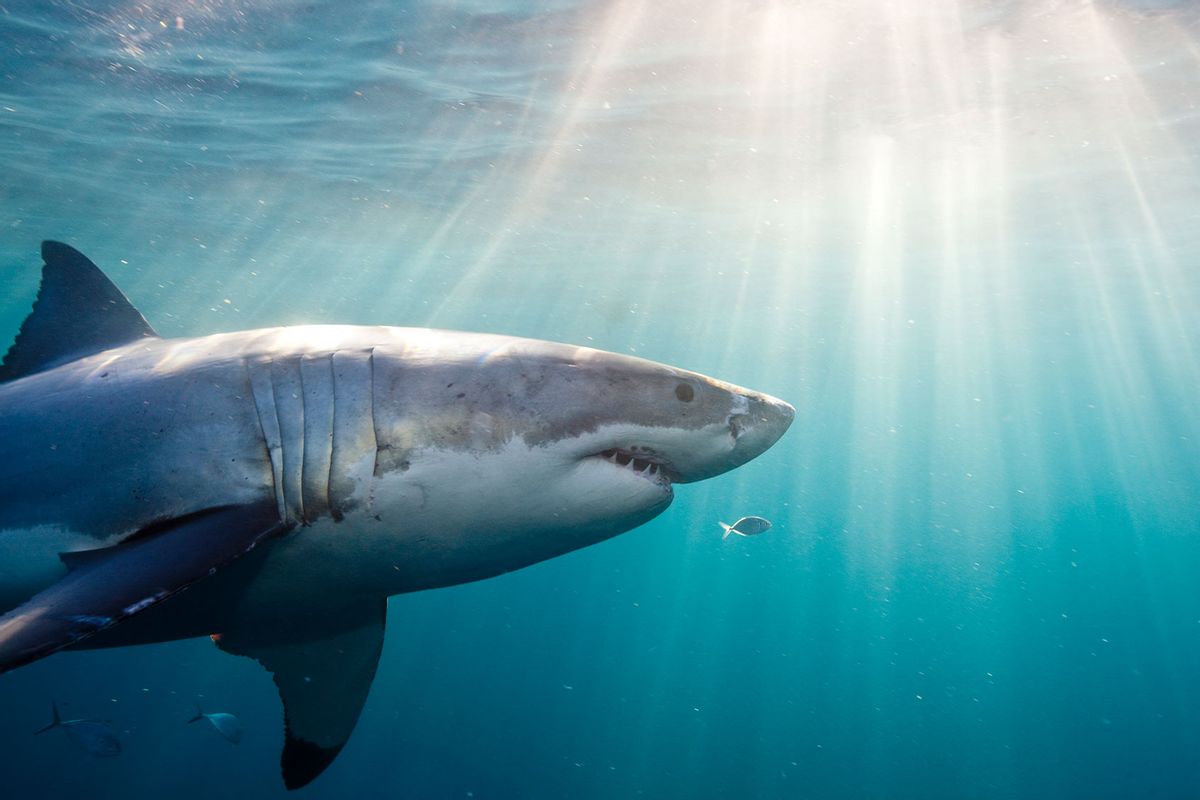As popular culture often depicts, a glimpse of a dorsal fin acts as a warning that a shark is nearby. In the iconic 1975 film "Jaws," a killer shark causes chaos in a beach community off Cape Cod. While the shark itself isn't revealed until the end, anticipation builds with the help of just the dorsal fin.
But reality is much different, as illuminated by a new study published in the journal PLOS ONE showing that sharks are more inconspicuous than previously thought. In fact, it's likely that at least in California, swimmers and surfers are spending more time in close proximity with sharks than they're aware of.
In the study, researchers at Cal State Long Beach Shark Lab flew 1,500 drone flights over 26 California beaches to capture aerial surveys of ocean waters. In total, between 2019 and 2022, they amassed over 700 hours of footage. They found that water users were in proximity to the sharks 97 percent of the days surveyed — stand-up paddle boarders and surfers were often the closest to the sharks, especially surfers beyond the wave breaks in the "line up."
Specifically, researchers discovered that juvenile white sharks (Carcharodon carcharias) gathered frequently at two aggregation sites growing up before becoming more solitary over time. Notably, shark sightings were rare during the winter and more common during the summer. The sharks were usually close to the wave break.
Over the surrey period, the researcher documented only one potential unprovoked shark bite at one of the observed aggregation sites.
"This study provides evidence that high human-shark spatio-temporal overlap does not lead to an increased bite frequency in southern California," the researchers stated. "And there are a number of possible explanations as to why JWS [juvenile white sharks] are not biting water users despite daily encounters."
This is one of the first studies to quantify human-shark overlap on beaches. As the researchers noted, previous studies assessed the effects of ecotourism on sharks or retrospectively tried to assess shark bite trends.
"Areas with high human-shark co-occurrence are assumed to have higher encounter rates and potentially, higher bite rates," the researchers noted. "Previous estimates of shark-human encounter rates have been made using proxies such as beach counts of people, which do not provide actual measures of human water use, and likely overestimate encounter rates."
Want more health and science stories in your inbox? Subscribe to Salon's weekly newsletter The Vulgar Scientist.
Over the surrey period, the researcher documented only one potential unprovoked shark bite at one of the observed aggregation sites. In spring 2020, a swimmer was reported bitten by a marine mammal. The swimmer stated that she saw a juvenile white shark in the area, but authorities couldn't "unequivocally" identify the bite.
Water users were in proximity to the sharks 97 percent of the days surveyed
"An aerial survey study conducted at La Reunion Island, a region known for high frequency of shark bites on people, found that areas of high shark-water user overlap did not result in increased shark bites on water users," the study stated. "In addition, the probability of unprovoked shark bites across California was estimated to be extremely low."
There have been 130 reported shark bites in California since 1950 and only 20 in Southern California since 2000.
"Under current conditions, JWS bite risk on nearshore water users remains extremely low, despite high daily encounter rates at aggregation sites," the researchers stated. "There are several potentially widespread impacts of this study."
One being a change in protocol when a shark is spotted at a beach.
"Using these methods, they can identify hotspots of shark activity at their beaches," the researchers stated. "Furthermore, instead of closing entire beaches, public safety officials may elect to restricting public beach access points to limit human-shark overlap at shark area use focal points."
Melissa Cristina Márquez, a marine biologist and shark scientist, told Salon via email that in her opinion, this study doesn't completely disprove the myth that if sharks are near people it could pose a threat to them.
"But it does contribute valuable information that challenges this common misconception," she said. "The study suggests that sharks near humans are not necessarily a danger or a threat and that understanding shark behavior, motivations and context is important when interacting with sharks."
Márquez emphasized that shark attacks are rare and they occur for a variety of reasons.
"It's important to note that sharks do not actively seek out humans as prey," she said. "In most cases, these [attack] incidents are a result of mistaken identity or curiosity-driven investigatory behavior."
Of course, the only 100 percent surefire way to prevent a shark bite is to keep people out of the water.
"But that isn't really going to happen, so focusing on public education and awareness programs to help people understand shark behavior, recognize potential risk factors and adopt safe practices when engaging in water activities is the next best thing," she said. "Additionally, implementing measures such as shark exclusion nets (which forms a complete barrier from the sea surface to the seafloor that completely encloses an area and prevents sharks and other marine animals from coming in), beach monitoring systems and increased patrolling in known shark habitats can help reduce the likelihood of interactions between sharks and humans."
Read more
about sharks

Shares